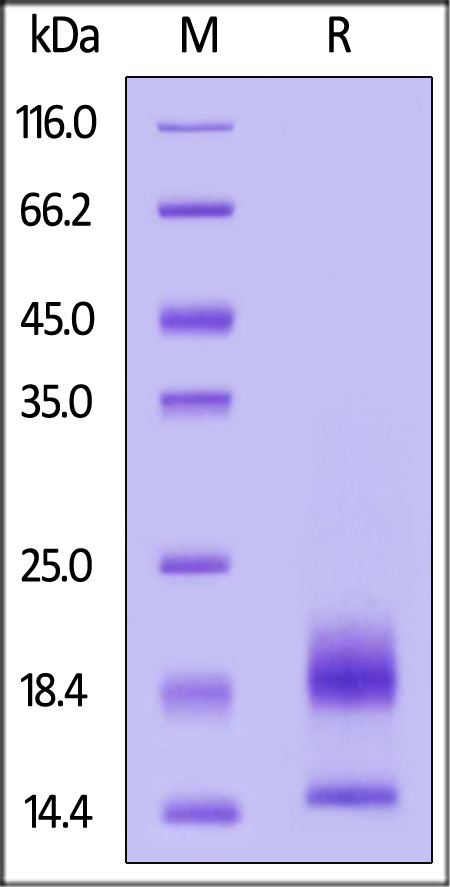分子别名(Synonym)
C-C motif chemokine 7,Monocyte chemoattractant protein 3,Monocyte chemotactic protein 3,MCP-3,NC28,Small-inducible cytokine A7,CCL7,MCP3, SCYA6, SCYA7
表达区间及表达系统(Source)
Human CCL7, His Tag (CC7-H52H6) is expressed from human 293 cells (HEK293). It contains AA Gln 24 - Leu 99 (Accession # P80098-1).
Predicted N-terminus: Gln 24
Request for sequence
蛋白结构(Molecular Characterization)

This protein carries a polyhistidine tag at the C-terminus.
The protein has a calculated MW of 10.8 kDa. The protein migrates as 14 kDa and 18-20 kDa under reducing (R) condition (SDS-PAGE) due to glycosylation.
内毒素(Endotoxin)
Less than 1.0 EU per μg by the LAL method.
纯度(Purity)
>90% as determined by SDS-PAGE.
制剂(Formulation)
Lyophilized from 0.22 μm filtered solution in PBS, pH7.4. Normally trehalose is added as protectant before lyophilization.
Contact us for customized product form or formulation.
重构方法(Reconstitution)
Please see Certificate of Analysis for specific instructions.
For best performance, we strongly recommend you to follow the reconstitution protocol provided in the CoA.
存储(Storage)
For long term storage, the product should be stored at lyophilized state at -20°C or lower.
Please avoid repeated freeze-thaw cycles.
This product is stable after storage at:
- -20°C to -70°C for 12 months in lyophilized state;
- -70°C for 3 months under sterile conditions after reconstitution.
电泳(SDS-PAGE)

Human CCL7, His Tag on SDS-PAGE under reducing (R) condition. The gel was stained with Coomassie Blue. The purity of the protein is greater than 90%.
背景(Background)
CCL7, also known as monocyte chemotactic protein-3 (MCP-3), is a CC (cysteine–cysteine) chemokine that is 11–18 kDa in size depending on the level of glycosylation. Its gene has been mapped to chromosome 17q11.2-q12 and is expressed in response to endogenous cytokines or exogenous bacterial products. This protein shares 60–71% homology with MCP-1 and MCP-2 chemokines and consequently binds similar receptors. Receptors CCR1, CCR2, CCR3, and CCR5 have been identified to bind CCL7 in both progenitor and immune cells.






















































 膜杰作
膜杰作 Star Staining
Star Staining











